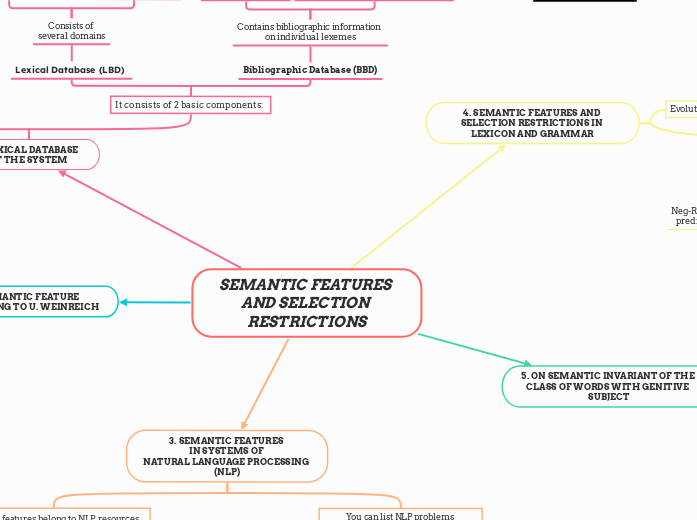SEMANTIC FEATURES AND SELECTION RESTRICTIONS
1. LEXICAL DATABASE
OF THE SYSTEM
Expert System for natural
language processing purposes
It consists of 2 basic components:
Lexical Database (LBD)
Consists of
several domains
Vocabulary presented in
machine-readable format
The user can obtain
information about:
--Morphology
--Syntactic features
--Semantic features
--Prosody
--Referential features
of individual lexical items.
Bibliographic Database (BBD)
Contains bibliographic information
on individual lexemes
The vocabulary
consists of
about 12,500 words
Syntactic and Semantic information
cannot be found
in existing dictionaries
3. SEMANTIC FEATURES
IN SYSTEMS OF
NATURAL LANGUAGE PROCESSING
(NLP)
You can list NLP problems
in which features are constantly used
Revealing
predicate-argument
relationships in
parsing algorithms
Disambiguation of a
lexically
homonymous
predicated word
Combination of verbs
with adverbs
that designate
time
place
reason
purpose
instrument, etc.
Semantic features
can be useful
in the process
Transfer semantic features
can be used to
distinguish texts that allow
liberal interpretations
of deviant or metaphorical texts.
4. SEMANTIC FEATURES AND SELECTION RESTRICTIONS IN LEXICON AND GRAMMAR
Evolution of semantic theory
Role in regulating selection restrictions
Examples
Neg-Raising
predicates
Semantic distribution
of conjunctions
Predicates introducing
indirect question
Semantic motivations
for syntactic behaviors
5. ON SEMANTIC INVARIANT OF THE CLASS OF WORDS WITH GENITIVE SUBJECT
The construction with genitive subject in Russian,
Specifically in contrast with the nominative case.
'X exists'
Determines the case
of the subject
in negative sentences.
'X takes place'
Example
Demonstrating
how the
presence or
absence
of the presupposition
of
existence affects
the
choice of case
for the subject.
2. SEMANTIC FEATURE
ACCORDING TO U. WEINREICH
U. Weinreich proposed
A distinction between a paradigmatic semantic feature and a transfer function.
The notion in
a broader sense
than in
transformational
grammar
The semantic feature has several purposes:
As a basis for
semantic agreement
Explain deviant
and
metaphorical readings
Add provisional semantic
content to an
ambiguous word
